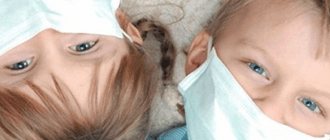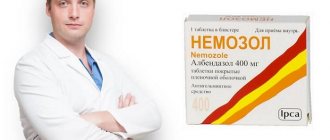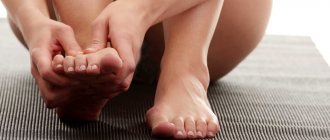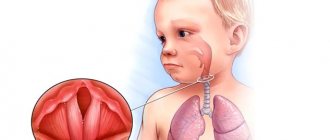What is thrush?
Thrush in the mouth is an inflammation of the mucous membranes caused by fungi of the genus Candida, which can be found anywhere on the human body, including in the mouth and intestines. Thrush in the mouth can happen to people of any age, but it most often occurs in infants, especially those under six months of age.
There is a possibility that the child has already had contact with the fungus. It is transmitted through saliva through hand-to-mouth contact, as well as when a baby passes through the birth canal during vaginal delivery.
If the fungus actively grows in the mouth, a child may develop thrush, which appears as a white coating. Thrush can be uncomfortable or painful, especially during feeding.
Thrush from the baby can spread to the mother's nipples if she is breastfeeding, which can also cause pain and discomfort when feeding.
About the disease
Thrush is one of the most common diseases that occurs against the background of increased activity of fungi of the genus Candida.
The disease got its name because of the characteristic white (“milky”) coating that forms on the affected mucous membranes. The pathogen is normally present in small quantities on the surface of the oral cavity, skin, and objects of daily use. However, this concentration of fungi, provided the immune system is functioning normally, is not enough to cause any clinical manifestations of pathology.
Newborns and infants are automatically at risk of developing the disease. This is due to the immaturity of the immune system and the minimum number of natural barriers to the penetration of fungi into the baby’s body. Therefore, thrush is a relatively common problem that many parents may encounter. In 90% of cases there is no need to be afraid of the disease, but you also cannot ignore the symptoms due to the risk of developing complications.
What are the causes of oral thrush in infants?
In most cases, the presence of Candida fungus is not dangerous, since Candida is “good bacteria” under control of the immune system. But in newborns, especially those under six months, the immune system is not yet fully developed, as a result the fungus begins to grow excessively, which leads to thrush in the mouth.
If your child is being treated with antibiotics, this may also increase the risk of thrush. Antibiotics are effective against bacterial infections, but can also kill “good bacteria.” When taking antibiotics, the body's natural defenses are weakened and fungal growth can get out of control.
Causes
There are many conditions for the occurrence of thrush:
- if the rules of hygiene for a newborn are not observed - there is no boiling regime for feeding supplies, breastfeeding hygiene is not observed, unwashed toys, teethers that are not treated daily, and in general all items that are used in caring for the child;
- if the mother suffers from candidiasis, then most likely the disease will be transmitted to the baby through contact;
- if the mother has vaginal candidiasis, it will be transmitted to the child during childbirth (and even during cesarean section);
- with frequent regurgitation, a favorable environment for the development of fungus is formed in the mouth;
- if the baby drinks little liquid, then thrush may also develop on the dry mucous membrane of the mouth;
- Candida fungi multiply quickly in a sweet environment, so it is undesirable to give your child sweets, especially drinks;
- teething, diarrhea, colds - all this weakens the immune system, which means the possibility of fungal growth;
- premature babies also often suffer from thrush;
- antibiotics suppress the natural microflora of the body and enable the disease to intensify;
- you can become infected during long-term treatment in a hospital;
- for chronic diseases - for example, diabetes.
Symptoms of thrush in infants
If you suspect your baby has thrush, you should visit your pediatrician to confirm the diagnosis and receive treatment recommendations.
Here's how thrush manifests itself in a baby:
- Difficulty feeding.
One of the first signs you may notice is that your baby acts restless during feeding, as if he is in pain or uncomfortable.
- White spots.
The spots resemble curdled milk and can appear on the tongue, lips, gums and roof of the mouth. Try to wipe them gently - if the stains do not go away this way, it may be thrush. If you don't look closely, these spots are not so noticeable, so make it a habit to look into your baby's mouth from time to time.
- Cracks in the corners of the mouth.
Another possible sign of thrush in a child's mouth.
- Mom's symptoms.
If you are breastfeeding and your nipples appear cracked, inflamed, there is a burning sensation, or you feel shooting pain in your nipples or breasts, these may be signs of thrush. Thrush can be transmitted to the mother from the baby during feeding. Later in this article we talk about how to continue breastfeeding if you have thrush.
Causes of Quincke's edema
There are many medications that can cause hives or swelling. These may be anticonvulsants, acetylsalicylic acid, antibiotics, iodine preparations, B vitamins, medicinal serums, sulfites, corticosteroids, eye medications, bronchodilators.
Anti-inflammatory nonsteroidal drugs increase skin sensitivity to histamine. This group of drugs is very dangerous for children prone to allergies. Atopic dermatitis and bronchial asthma will increase the risk of developing Quincke's edema.
Many food products, or rather the additives contained in them, also cause an allergic reaction. Such allergenic additives include monosodium glutamate, sulfites, tartrazine dye, etc. Allergies can be caused by Chinese dishes; of course, children are not given seafood, but cases of angioedema caused by the smell of fish have been observed.
Fish, strawberries, lemons, egg whites, bananas, and chocolate contain substances that release intracellular histamine. This is why these foods should not be given to children under three years of age. Some foods themselves contain large amounts of histamine: sausages, sauerkraut, cheese. Hereditary complications, gastrointestinal diseases, allergic reactions in the mother during pregnancy increase the possibility of angioedema.
Quincke's edema can appear from plant pollen. Children from three to nine years old can develop hay fever, an allergic disease caused by hypersensitivity to plant pollen. According to statistics, in 11% of children who suffer from hay fever, the disease is complicated by Quincke's edema.
Insect bites can also cause angioedema. Insect saliva contains histamine and other substances. If parents were allergic to insect bites, then it is better to protect children from this.
How to treat thrush in a baby
If you notice possible symptoms of thrush in yourself or your child, contact your doctor to confirm the diagnosis. The doctor will prescribe the necessary treatment.
Sometimes thrush will go away on its own within a few weeks, but your doctor may also prescribe antifungal medications.
Thrush: treatment with folk remedies
It is not recommended to buy medications to treat thrush in infants without consulting a doctor.
Mothers often resort to folk remedies: they treat spots in the baby’s mouth and their nipples with a soda solution, remove sugar, dairy products, and products containing yeast from their diet.
There is no scientific evidence that these methods are effective, and they should only be used in conjunction with treatment prescribed by your doctor, and not instead of it. Do not use over-the-counter medications or home remedies without your doctor's approval.
If the inflammation does not go away after a few weeks of treatment or goes away and starts again - especially if the baby is over nine months old - talk to your doctor about the possible causes.
Treatment of thrush
The principles of treating thrush include both the elimination of provoking factors and the fight against the pathogen itself. In infants, the mother plays an important role in timely diagnosis, because the child is unable to formulate his complaints. Even with timely consultation with a doctor, treatment of children is complicated by the fact that not every drug can be used in infancy. Therefore, the mother’s efforts should be aimed at eliminating factors contributing to the development of thrush. This is the prevention of regurgitation, which is ensured by the correct feeding technique, in which air does not enter the child’s stomach, as well as by carrying the child “in a column” after swallowing air. Immediately after feeding, you should not change clothes or play with the baby - let him lie down for 2-3 minutes, this will also reduce the likelihood of regurgitation.
If the measures taken do not have an effect, then it is necessary to begin drug treatment. The most common method is to treat the child’s oral mucosa with a 10% soda solution (1 teaspoon per glass of boiled water at room temperature). Use a sterile swab dipped in the solution to wipe the oral mucosa, not forgetting the space under the tongue, the inner surfaces of the cheeks and lips. Treatment is carried out every 2 hours, approximately 30 minutes before or after meals. Treatment usually lasts 5-10 days. The effectiveness of this simple method is based on changing the acid-base balance in the oral cavity - in an alkaline environment, the vital activity of the fungus is difficult.
In children older than six months, antifungal drugs can be used in addition to local treatment. Only a doctor can prescribe a drug and the timing of treatment; initiative here is unacceptable. You should not stop treatment on your own after the symptoms disappear - this may lead to relapse.
For children over 1 year of age, for local treatment, the doctor may prescribe nystatins, a solution of borax in glycerin, Candida solution, aqueous solutions of antibiotics, Canesten. Most often, treatment is carried out after eating and using the oral cavity 3 times a day for 10 days. These drugs are effective in mild cases, and in more advanced cases, Pimafucin, Lugol's solution, and Clotrimazole are used. (!) The described drugs have contraindications; consultation with a specialist is necessary to determine the age-specific dose and treatment period.
In addition to the means of official medicine and after consultation with a doctor, you can also use traditional methods. Honey (1:2 aqueous solution) is often used for external treatment; however, this healing product can cause allergic reactions in children. In this case, instead of honey, raspberry, carrot juices, decoctions of calendula and St. John's wort are used.
Ways to prevent thrush in infants
By following preventive measures, you can reduce the risk of developing thrush:
- Wash your child's hands regularly, especially if he puts them in his mouth and sucks his fingers. The mother and everyone who comes into contact with the baby should also wash their hands regularly.
- Regularly sterilize pacifiers, teethers, bottle nipples, and anything else that goes into your baby's mouth.
- Wash towels, diapers, and clothes that may have been in contact with fungus at a temperature of at least 50 degrees.
- Sterilize all parts of the breast pump that touch the breast and milk after each use.
- Remove expressed breast milk from the refrigerator immediately before feeding to prevent fungal growth.
- If you suspect that stored expressed milk may be contaminated with fungus, it is better to get rid of it.
- Practice good breast hygiene by changing your disposable breast pads regularly and changing your bra every day.
Preventing the recurrence of thrush
Oral thrush in children can be difficult to get rid of, especially if you are breastfeeding, also because the fungus is so contagious. Thrush can be transmitted between mother and baby through the nipple. You can get the fungus from your household and infect them through bedding, dishes and cutlery.
Therefore, it is extremely important that mother and baby (and other family members if infected) are treated at the same time.
It is also useful to follow all preventive measures while treating the cause of thrush.
Breastfeeding with thrush
If you are breastfeeding, thrush can cause a lot of discomfort for you and your baby.
It is important to start treatment as soon as possible, so go to the doctor as soon as possible to confirm the diagnosis and prescribe treatment. Please note that symptoms may not go away immediately.
Experts recommend not stopping breastfeeding if you have thrush. Here are some ways to relieve discomfort without interfering with your milk supply:
- Try to have shorter feedings, but more often.
- Wash your nipples with water after each feeding and dry them before putting on a bra.
- If cracked nipples make breastfeeding painful for you, try expressing milk and giving it to your baby from a small cup.
- Pain can be relieved with medications. Talk to your doctor about which medications are safe to take while breastfeeding.
Other reasons
Sore breasts and nipples are not always caused by thrush. If you experience sharp pain in your breasts during or after feeding, or severe pain in your nipples, try changing your feeding position or letting your baby latch on again. Sometimes this is enough to relieve the pain.
If cold compresses or air baths increase the pain, the cause of the pain may be contraction of the blood vessels in the nipple area.
Another cause of pain may be mastitis - inflammation of the mammary gland due to stagnation of milk, poor emptying of the mammary gland, as well as a cracked nipple.
These conditions are often confused with thrush, so you should visit a doctor who can pinpoint the cause of your discomfort.
FAQ
- In some babies, thrush causes inflammation in the mouth, as well as pain and discomfort during feeding. But many babies do not experience any discomfort.
- In some cases, thrush may go away on its own, but it is important to see a doctor as he or she may prescribe antifungal treatment.
- If the corners of your baby's mouth are cracked or you notice white spots on the tongue, lips, or inside the mouth, it may be thrush. Another sign of thrush is discomfort or pain during feeding.
- Doctors usually prescribe antifungal medications to treat thrush in children. If thrush appears in the mother or one of the family members, it is important to treat everyone at the same time to avoid transmitting the infection to the baby.
Life with a baby is full of surprises. One minute you are touched by that first toothless smile, and the next minute you look anxiously into the baby’s mouth.
Thrush in infants is a common problem that parents face. Just follow the doctor's recommendations, and everything will gradually pass, and you and your baby will be able to enjoy moments of closeness during feeding again.
Diagnosis of thrush
“SM-Doctor” is a multidisciplinary medical center specializing in the identification and treatment of all types of diseases in children from 0 to 18 years old.
Thanks to modern equipment and experienced staff, our clinic provides patients with a full range of diagnostic services. This ensures quick and high-quality detection of thrush. The doctor can diagnose fungal infection of the mucous membranes during the initial examination of the child. After collecting anamnesis and analyzing the patient’s complaints, the doctor assesses the condition of the affected area of the body. If a characteristic plaque is detected in combination with the above symptoms, a preliminary diagnosis is made. To confirm it, the following additional procedures are used:
- microscopic analysis of scrapings from the affected area of the mucous membranes;
- traditional laboratory tests - general and biochemical analysis of blood and urine.
If there is a suspicion of concomitant somatic pathology, the doctor may refer the child for consultation to related specialists. Sometimes weakened immunity can be a consequence of gastritis, cholecystitis or other diseases of the internal organs.










